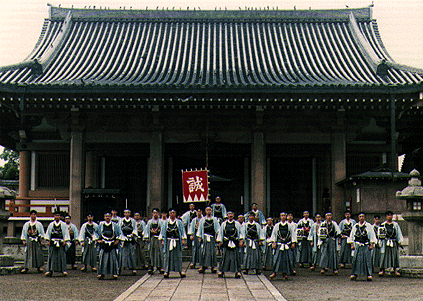
After the arrival of Commodore
Perry in 1853, Japan was thrown into chaos and fear.
As the Japanese had never seen
the armed blackships, they were worried about the security of Japan.
Many samurai began to doubt
the power of the Bakufu in defending the country against foreign powers,
The slogan "Sonno-Joi" ( Rever
the Emperor, dispel the barbarians ) was winning more and more support,
such that samurai abandoned
their han and came to Kyoto to join the revolutionary movements.
Such roshi ( masterless samurai
, but not ronin and definitely not rurouni ) increased in Kyoto.
Most of the roshi still did
not have a clear idea of what movement or who they should follow.
All they knew was that they
were impatient and eager to do something to defend Japan.
There were myriads of schools
of thought - Sonno-joi, open up the country to learn from the gaijin,
and in turn attact them using
the same technology to support the Bakufu.
The Bakufu decided that it would
be to their advantage if they took such roshi without any stand yet into
their service.
Hence, Roshi-tai ( bands of
masterless samurai ) were formed and enlisted under respective Bakufu samurai,
where the "entry requirements"
were one's sword skills ( kenjutsu matches, something like an exam, were
held ).
In the district of Tama near
Edo, there was a kenjutsu dojo, the Shieikan, practising the Tennen Rishin
Ryu.
The master was Kondo Isami,
and among the students are Hijikata Toshizo, Okita Souji and Inoue Genzaburo.
These four were like brothers,
with Okita as the youngest, yet the strongest.
Among the regulars in the dojo
where they get free meals; there were Yamanami Seisuke, Harada Sanosuke
and Nagakura Shinpachi.
When Kondo and Hijikata heard
of the formation of Roshitai in Kyoto and being the patriotic hunks that
they were,
they went to Kyoto with a few
other disciples of Tennen Rishin-ryu ( including all of the above named
),
leaving the dojo in the care
of Hijikata's elder brother.
In Kyoto, they were enlisted
under Kiyokawa Hachiro, after passing the "entry requirement exams".
13 roshi, including Kondo and
disciples, were appointed "Roshigumi" ( Guardians of Kyoto)
by Matsudaira Katamori, the
Daimyo of Aizu ( now Hukushima ).
Now, although Kiyokawa acted
in public like a pro-Bakufu, he was actually on the other side.
What he wanted to do was to
gather a troupe of roshi in the name of the Bakufu, but to train these
roshi to be Ishin Shishi.
He had planned with the other
Ishin Shishi to attack the gaijin settlement at Yokohama,
setting fire to the buildings
and killing the foreigners,
so that the Bakufu's foreign
diplomacy, as well as their image, would plummet as low as it could get.
The Bakufu had news of this,
and had to act before their plan could be carried out.
On 13 April, 3rd year of Bunkyu,
Kiyokawa was thus recalled back to Edo.
After that, Kondo and disciples
insisted on supporting the Bakufu, and they set up the Shinsengumi, with
13 members.
The Shinsengumi were recognized by their pale-blue overcoats and the kanji character " Makoto ".
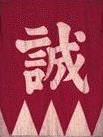
As the maintenance of peace was
more important than anything else,
the Shinsengumi surround their
opponents and attack together in battle,
though their true strength was
to adopt one technique and improve on it.
The first committee was as follows
:
Joint Captains: Serizawa Kamo,
Kondo Isami, Niimi Nishigi
Vice Captains: Hijikata Toshizo,
Yamanami Keisuke
At this point, several new members joined in, including Saito Hajime.
Serizawa Kamo was famous for
wielding an iron fan as a weapon and frequented brothels, getting drunk
and killed people at whim.
Always using his power as "
Captain of the Shinsengumi " to cover up his wrongs all the time.
This caused the birth of the
nickname, Miburo ( Wolves of Mibu ) for they first assembled in Mibu,
and also due to the way they
attack their opponents. The Shinsengumi was thus despised throughout Kyoto.
It was the last straw for Kondo
and Hijikata when Serizawa summoned a prostitute to the hostels of the
Shinsengumi
- they were men of high morale
and held fast to the codes of samurai.
Niimi wasn't much better off.
As the Shinsengumi was travelling to Kyoto, a fire broke out at the inn
that they were staying,
and Kondo took all the blame
for negligence. He was further mocked by Niimi and Serizawa.
A few weeks later, Hijikata
and the others uncovered the truth : Niimi and Serizawa had been demanding
some discount
( or some other luxurious services
) from a certain shop-tender, who declined to obey them as their demands
were just too ridiculous.
Angered, the two of them fired
a cannon - which travelled with the Shinsengumi and was being kept
in the inn's store - at the shop.
However, they blundered somewhere,
and the inn caught fire.
Hijikata managed to uncover
enough evidence to convict Niimi only, and he ruled Niimi to commit seppuku.
After which, the hostility between
Serizawa and Kondo became more intense.
Finally, on 18th September 1863,
Serizawa and other corrupted members were assasinated by a special killer
group,
comprising of Okita, Inoue,
Todo, Harada, and Yamanami.
Corrupted members were then
either ordered to commit seppuku, decapitated,
or assasinated to prevent further
tarnish of the Shinsengumi's reputation.
Entry requirement exams were
made more difficult and also emphasized on bushido.
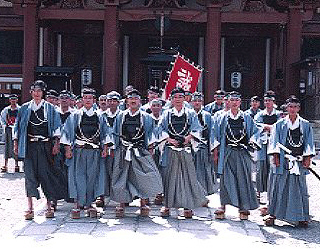
Under the new leadership of Kondo
Isami and Hijikata Toshizo,
Acting upon orders from the
Kyoto Shugoshoku, an official appointed to maintain peace in Kyoto (1835-69),
the Shinsengumi was a special
police troop vowed to protect Kyoto with their swords, patrolling the streets
of Kyoto and keeping the peace.
Ishin leaders like Katsura Kogoro,
Kido Koin and Takasugi Shinsaku set up the Kiheitai to plot the downfall
of the Bakufu.
Radical actions of the Ishin
Shishi, such as setting fires to the gaijin's abodes made the Shinsengumi
very suspiscious of other roshi in Kyoto.
One would be cut down at once
if he could not produce a satisfactory identity when questioned by the
Shinsengumi members.
In the Bakumatsu, Kyoto was a
living hell where people died and blood flowed every single day.
This made the Shinsengumi quite
fearsome, especially Hijikata,
for he was strict and merciless
when it comes to punishments and cutting down suspicious persons.
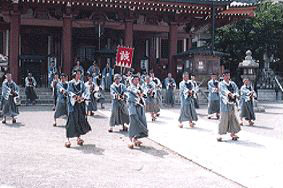
One of the major incidents involving
the Shinsengumi was the Ikeda-ya Incident in 1864.
The Ishin Shishi had planned
to set Kyoto on fire, and in the midst of chaos assasinate the important
members of the Bakufu.
The Shinsengumi received news
and raided the Ikeda-ya and killed most of the Ishin Shishi involved, thus
prevented a disaster.
The Shinsengumi not only became
heroes overnight, they also redeemed thenselves in the eyes of the commoners
since the Serizawa Incident.
The Shinsengumi was also involved in the defence of the imperial palace in the Hamaguri Gomon Incident.
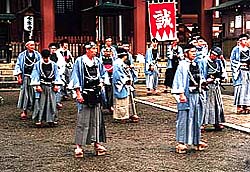
Although the Shogun surrendered
to the Emperor to prevent unnecessary loss of lives,
the Shinsengumi remained loyal
to the Shogun even to the extent that even during the early Meiji era,
the Shinsengumi fought against
the imperial forces in the Boshin War in 1868.

